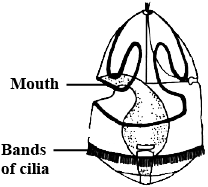
The larva of ‘tongue worm’ is known as
A. Veliger
B. Tornaria
C. Echinopluteus
D. None of the above
Answer
483.6k+ views
Hint: The Hemichordata Balanoglossus sp. is known as tongue worm. Tornaria larva is of some hemichordata species.
Complete answer: Balanoglossus sp. is a Hemichordate species. It belongs to the class Enteropneusta of the phylum Hemichordata.
Being a Hemichordate, it links between non-chordata and chordate animals. Because of this reason it has an important evolutionary significance. It is a burrowing animal and exclusively marine. These ocean-dwellers are also called acorn worms. In Hemichordates, their body is divisible into proboscis, collar, and trunk- this is the basic unique characteristic feature. Head and tail are absent in Balanoglossus.
The proboscis of this animal protrudes outside and appears like a tongue. This is the reason they are called ‘tongue worms’. The young swimming juveniles produced by them are called Tornaria larva. It is a planktonic larva. Tornaria appears very similar to the bipinnaria larvae of some Echinoderms (Starfishes). They have convoluted ciliary bands running around the body.
Tornaria larva was first described by Muller, in 1850. It possesses an oval and transparent body. It measures up to 3 mm in size. At the anterior end of its body, a tuft of cilia and a pair of eye spots are present. Its digestive system is differentiated into oesophagus, stomach and intestine.

So, the correct answer is B. Tornaria.
Note: The group of parasitic crustaceans called ‘Pentastomida’ are also commonly called tongue worms. They basically belong to the subphylum Crustacea. It is assumed that they are the connecting links between annelids and arthropods- Though it is a debatable concept.
Complete answer: Balanoglossus sp. is a Hemichordate species. It belongs to the class Enteropneusta of the phylum Hemichordata.
Being a Hemichordate, it links between non-chordata and chordate animals. Because of this reason it has an important evolutionary significance. It is a burrowing animal and exclusively marine. These ocean-dwellers are also called acorn worms. In Hemichordates, their body is divisible into proboscis, collar, and trunk- this is the basic unique characteristic feature. Head and tail are absent in Balanoglossus.
The proboscis of this animal protrudes outside and appears like a tongue. This is the reason they are called ‘tongue worms’. The young swimming juveniles produced by them are called Tornaria larva. It is a planktonic larva. Tornaria appears very similar to the bipinnaria larvae of some Echinoderms (Starfishes). They have convoluted ciliary bands running around the body.
Tornaria larva was first described by Muller, in 1850. It possesses an oval and transparent body. It measures up to 3 mm in size. At the anterior end of its body, a tuft of cilia and a pair of eye spots are present. Its digestive system is differentiated into oesophagus, stomach and intestine.

So, the correct answer is B. Tornaria.
Note: The group of parasitic crustaceans called ‘Pentastomida’ are also commonly called tongue worms. They basically belong to the subphylum Crustacea. It is assumed that they are the connecting links between annelids and arthropods- Though it is a debatable concept.
Recently Updated Pages
Master Class 12 Economics: Engaging Questions & Answers for Success

Master Class 12 Maths: Engaging Questions & Answers for Success

Master Class 12 Biology: Engaging Questions & Answers for Success

Master Class 12 Physics: Engaging Questions & Answers for Success

Master Class 12 Business Studies: Engaging Questions & Answers for Success

Master Class 12 English: Engaging Questions & Answers for Success

Trending doubts
Which are the Top 10 Largest Countries of the World?

Differentiate between homogeneous and heterogeneous class 12 chemistry CBSE

Draw a labelled sketch of the human eye class 12 physics CBSE

What is the Full Form of PVC, PET, HDPE, LDPE, PP and PS ?

What is a transformer Explain the principle construction class 12 physics CBSE

What are the major means of transport Explain each class 12 social science CBSE




